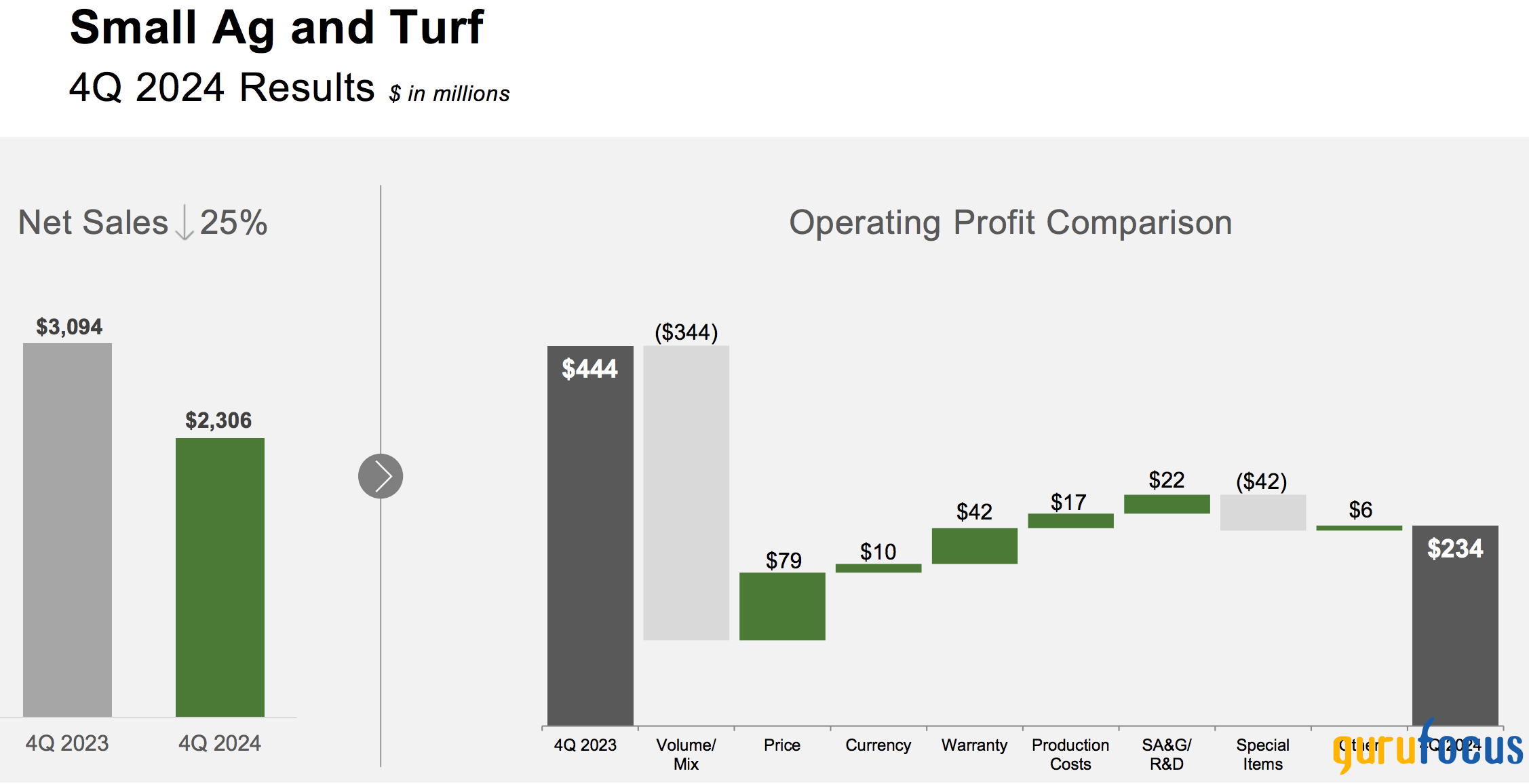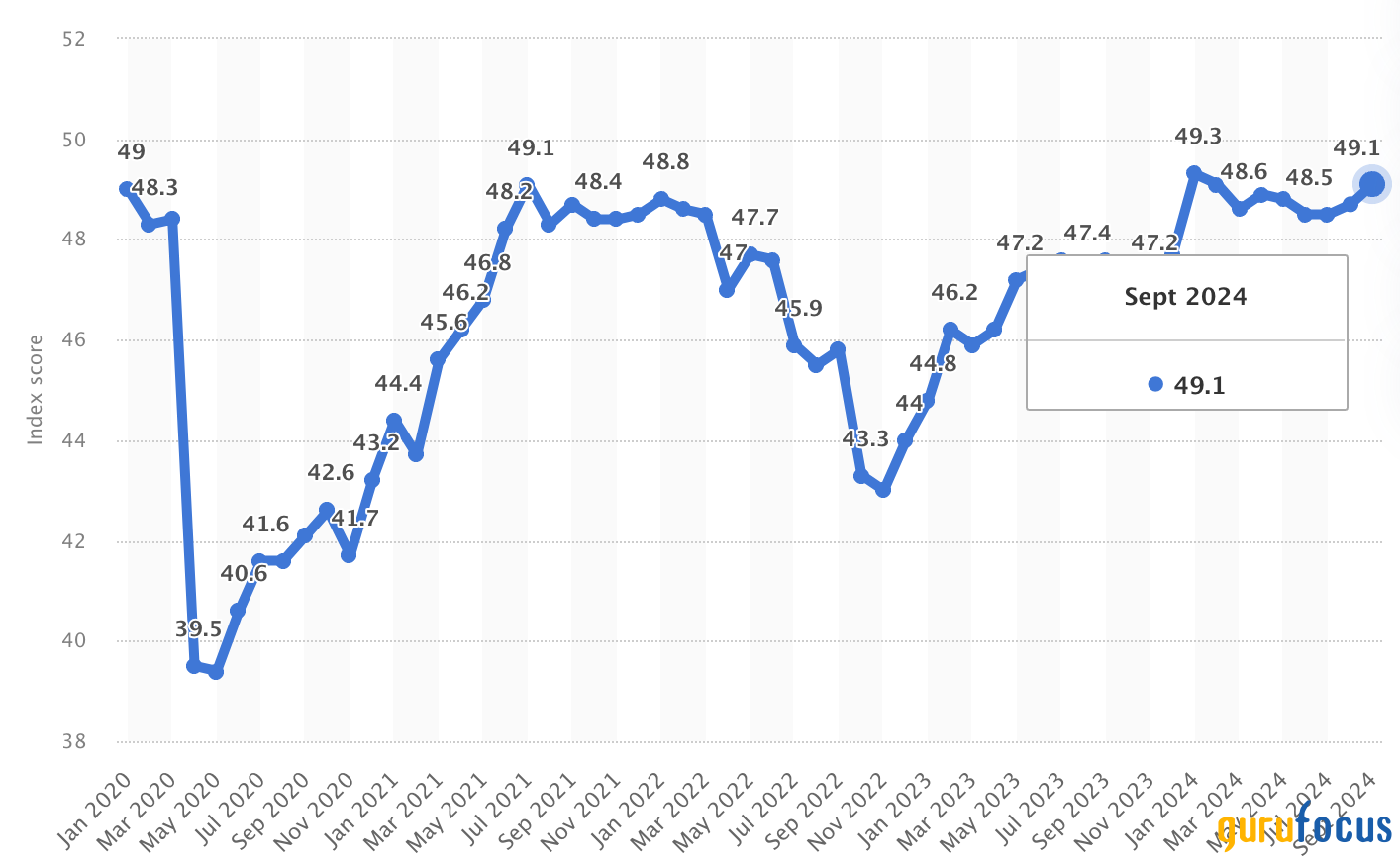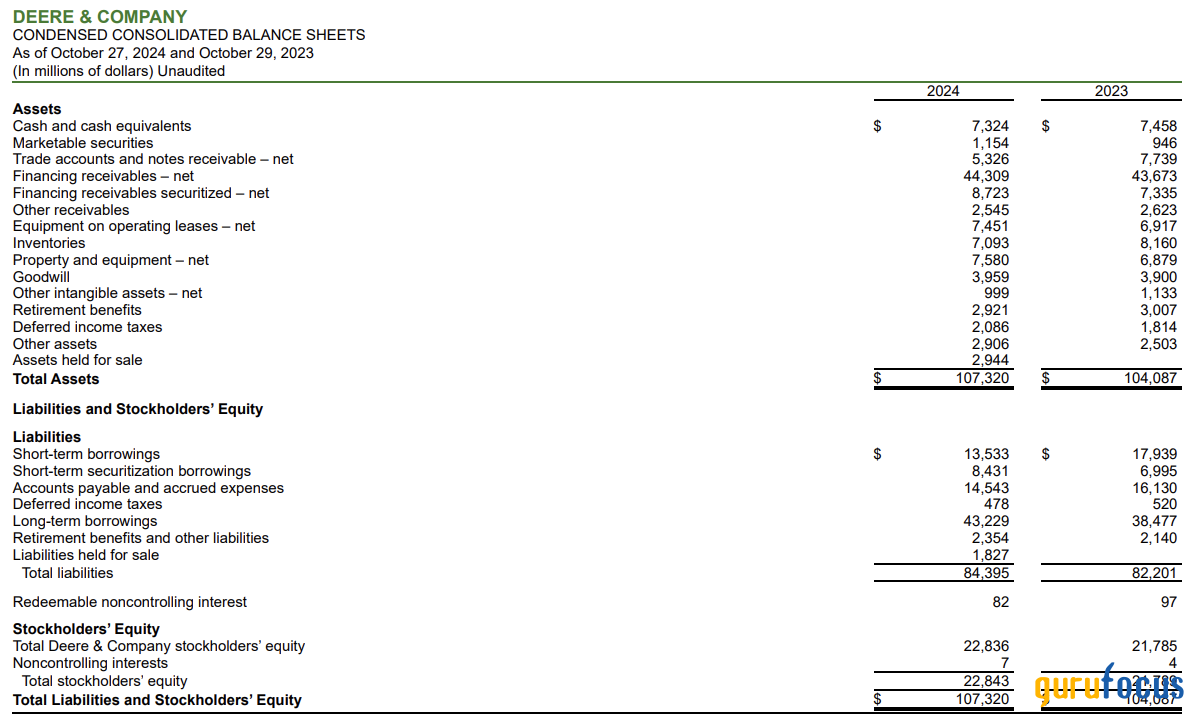Consumer discretionary stocks have experienced momentum lately as interest rates have lowered and consumer sentiment has enhanced. Among the beneficiaries is Deere and Company. The U.S. juggernaut's stock has surged by over 10% month-over-month, consequently raising market participants' interest in its prospects.
Although Deere's stock has delivered consistent returns throughout the past economic cycle, it remains prone to cyclical market activity. Fortunately, indicators suggest Deere's cyclical component is poised to benefit in late 2024 and 2025; here's why.
Latest News and Performance
Deere and Company reported its full-year results on November 21st. Despite experiencing softer results, Deere's stock rose as the manufacturer surpassed its fourth-quarter revenue target by $1.87 billion and its earnings-per-share target by 62 cents.
Deere generated $11.143 billion in quarterly sales, down from $15.412 a year earlier. One of the primary culprits of Deere's revenue decline was its production and precision agriculture segment, which experienced a 38% decline in sales (to $4.305 billion).

Source: Deere and Company
Furthermore, Deere's small agriculture and turf segment experienced a decline, softening by 25% year-over-year to $2.306 billion, while its construction and forestry products also sustained setbacks, illustrated by the segment's 29% year-over-year decrease in sales.

Source: Deere and Company
Lastly, Deere's financial services segment achieved $173 million in fourth-quarter revenue, down from $180 million a year earlier, showing that elevated lending rates were insufficient to protect the segment against the impact of lower company sales.
Fundamental Analysis: Why Might A Recovery Occur?
Top-Down
There's no doubting the fact that Deere's sales figures communicate temporary pressure. However, as mentioned in the introduction, cyclical aspects are improving, which might be reflected in Deere's financial results during 2025.
Among Deere's key cyclical benefactors is the interest rate environment. Global interest rates have pivoted, allowing corporates to finance their durable goods at a lower cost. For example, the United States has experienced a 75 basis point decrease in rates since mid-September, providing relief to consumers.

Source: Trading Economics (Federal Funds Rate)
Furthermore, global consumer sentiment has improved with factors such as lower interest rates, stabilized inflation, and settled national elections being likely contributors. Assuming stressed events stay sidelined, this trend will likely resume into next year, providing consumer durable goods companies like Deere with valuable systematic support.

Source: Statista (Global Consumer Confidence)
Bottom-Up Variables
Deere's operating profits slipped year-over-year. Nonetheless, a few arguments against sustained margin compression have emerged.
Firstly, inflation's volatility has cooled, meaning Deere's direct costs might stabalize in 2025. More specifically, raw materials and shipping costs seem less pressured than in Deere's trailing year. In addition, Deere will likely benefit from the aforementioned consumer sentiment recovery, providing it the necessary latitude to add markup to its products.

Source: Deere's SEC Filing (Income Statement)
Furthermore, unlike some manufacturers, Deere has a positive degree of operating leverage (DOL) ratio, which suits Deere as companies with high fixed costs can scale DOL, leading to margin expansion. Some might disagree, but Deere has a sublime opportunity to expand its margins back to normalized values in 2025.

Source: Gurufocus (Degree of Operating Leverage)
Another noteworthy consideration is Deere's supply chain efficiency and what artificial intelligence (AI) could mean for its inventory optimization. Deere's product line has increasingly leveraged AI in recent years. However, many look past the benefits that AI might add to the company's supply chain through inventory management, consumer targeting, and unit cost reduction.
A relative comparison shows that Deere has a respectable inventory days ratio, meaning it has streamlined its inventory management process, yet AI adds room for improvement and subsequent margin expansion.

Source: Gurufocus (Days Inventory)
A view of Deere's balance sheet shows that its leverage ratio, calculated as its total assets-to-shareholders equity ratio, is 4.7x, implying it is a highly leveraged company. Moreover, the company's cost of debt is around 5.17%, which, is conceivably high for a mature stage company.
Notwithstanding the above, Deere has a cash position of approximately $1.154 billion, reflecting its substantial short-term liquidity, allowing it to restructure its debt in today's lower interest rate environment. Whether Deere will act on this opportunity or not remains to be seen. Nonetheless, the opportunity is intact, and lower interest expenses seem probable.

Source: Deere's SEC Filings (Balance Sheet)
Valuation Metrics and Dividends
Neither a relative comparison nor an absolute view of Deere's valuation metrics conveys a deep value opportunity. Instead, the company's substantial market position and fundamental prowess mean it has strong value accumulation attributes.

Source: Author's Work, Data From Seeking Alpha (Price Multiples)
Furthermore, Deere's justified price multiples will likely expand when cyclical effects kick in. The company's key price multiples remain below their five-year averages, suggesting the stock trades at a normalized discount. This is another way of saying that Deere's stock is trading lower than it would under average economic conditions.

Source: Author's Work, Data from Seeking Alpha (Price Multiples)
An additional consideration is Deere's dividend. A forward dividend yield of 1.27% might seem tame, but Deere's dividend growth and consistency stand out. For example, the company's dividend has grown by 14.10% per annum over the past five years, suggesting investors' going-out dividend yield will be higher than their going-in yield.

Source: Author's Work, Data From KoyFin (Dividend Metrics)
Noteworthy Risks
Technically Overbought
The relative strength index measures a stock's relative buying versus selling power. As a rule of thumb, an RSI above 70 suggests a stock is temporarily overbought, whereas an RSI below 30 indicates a stock is oversold.
Deere's RSI was solidly above 70 at the time of writing this article, which, given the aforementioned, means the stock might be overbought. Therefore, short-term mean reversion remains a strong possibility, especially after Deere's latest surge.

Source: Trading View (Relative Strength Index)
President Trump's Tariff Plan
Newly elected U.S. President Donald Trump is expected to order tariffs on certain imported goods to lure foreign manufacturers back to the United States.
Whether President Trump's plan will suffice remains to be determined. Moreover, the broad-based economic impact of such tariffs remains up for debate. Nonetheless, the consensus is that prices of most value-added goods will surge if aggressive tariffs are applied.
As mentioned, the benefits versus implications of an aggressive tariff policy remain opaque. However, the uncertainty surrounding the policy's causes versus effects might prompt investors to avoid consumer stocks until the dust settles.
Final Word
Although facing slower year-to-date financial performance, key top-down indicators suggest that Deere is set to benefit from cyclical tailwinds. Furthermore, Deere possesses telling bottom-up features, reflected by its operating ratios. Its operating ratios are complemented by seasonally undervalued fundamental price ratios, communicating a cyclical investment opportunity.
Deere and Company's stock isn't risk-free. However, history shows that it serves buy-and-hold investors, especially when bought at a cyclical discount.
